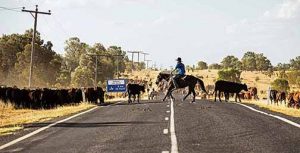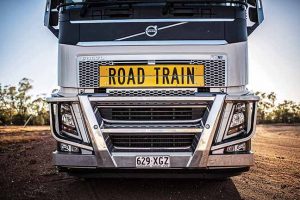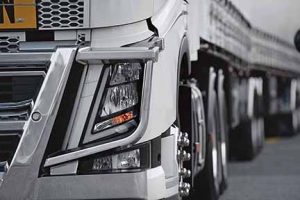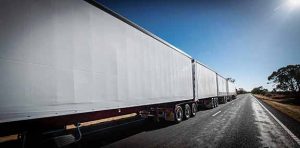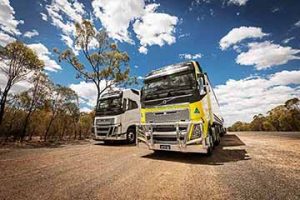Australian road trains make for an interesting long-truck configuration that could provide a clue or two to how truck platooning could work or not work.
Story by: Will Shiers
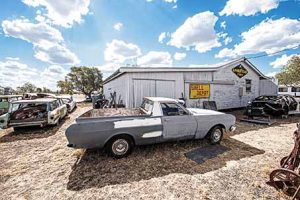 “Emus explode in a colourful cloud of feathers,” explains the driver of a 53.5 m road-train when asked about what caused the bloody mess on the front of his bonneted Mack. But of course, emus aren’t the main reason why every heavy truck in Australia is fitted with a bull-bar (aka roo-bar). There are considerably more kangaroos than people Down Under, and they have a nasty habit of hopping out in front of trucks. Hit a big one at 100kph, and it will do some serious damage. Even with a bull-bar in place, it’s still likely that the initial impact will destroy a headlamp assembly, and then there’s a good chance that the carcass will rip out airlines and fuel pipes as it tumbles under the truck. Of course, no driver wants to intentionally kill an animal, but when running at 50 m and 120-tonnes, sudden swerves and emergency stops just aren’t viable options. There are however ways of reducing the chances of bending a bull-bar, and especially when it involves a 52 m Volvo FH16 road train while travelling into the outback.
“Emus explode in a colourful cloud of feathers,” explains the driver of a 53.5 m road-train when asked about what caused the bloody mess on the front of his bonneted Mack. But of course, emus aren’t the main reason why every heavy truck in Australia is fitted with a bull-bar (aka roo-bar). There are considerably more kangaroos than people Down Under, and they have a nasty habit of hopping out in front of trucks. Hit a big one at 100kph, and it will do some serious damage. Even with a bull-bar in place, it’s still likely that the initial impact will destroy a headlamp assembly, and then there’s a good chance that the carcass will rip out airlines and fuel pipes as it tumbles under the truck. Of course, no driver wants to intentionally kill an animal, but when running at 50 m and 120-tonnes, sudden swerves and emergency stops just aren’t viable options. There are however ways of reducing the chances of bending a bull-bar, and especially when it involves a 52 m Volvo FH16 road train while travelling into the outback.
Platooning
The UK is about to embark on a platooning trial. It could be a waste of time and money. Daimler can’t make the technology work on North America’s big open roads, so why does one think it has potential on the crowded island? Instead of linking them wirelessly, doesn’t it make more sense to join the trucks mechanically? While numerous European countries have already introduced longer vehicles, the real experts are the Australians, who have been refining the road train concept over the past 80-plus years. Arriving at Brisbane, which is the home of Volvo Trucks, Australia, a plan hatched by Volvo’s driver trainers Bill Manton and Matt Wood to demonstrate three different truck and trailer combinations starts to take shape. Heading out of the city and into the Outback, the truck gradually starts to grow, adding trailers as legislation permits. This would enable experiencing the three most popular combinations that are found in Australia.
At the disposal are a pair of locally-built Volvo FH16 600s, and four trailers. A popular prime-mover for road-trains, the 700 hp FH16 in Australia differs from the European spec. version in a number of ways. The most notable is that it’s a EuroV. As yet Australia has no plans to adopt the latest European emissions standards. Like just about every other prime-mover sold in Australia and New Zealand, both the trucks are 6x4s. Unlike in North America where double-drive is frequently specified out of habit rather than a necessity, the extra traction provided by the additional drive-axle is required for moving such heavyweights. The trucks’ twin fuel tanks carry 1,220-litres of diesel (they are split to hold 690-litres and 530-litres), while a neatly designed 140-litre AdBlue tank is slung under each chassis.
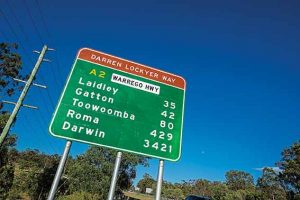 The most obvious differences, externally, are bull-bars (a heavy-duty aftermarket one on the green and yellow truck and a more aerodynamic genuine Volvo part on the white one). They are an absolute must in this part of the world, and can easily prevent thousands of pounds worth of damage in the event of an animal strike. Metal guards, which are fitted on the factory line, protect the windscreens from stones and bird strikes. Unlike in Europe, where FH16s tend to have more bells than the Vatican and more whistles than a referee’s convention, the interiors are poverty spec. here in Australia. Only one has a factory-fit fridge, and you have to operate the blinds and sunroof manually.
The most obvious differences, externally, are bull-bars (a heavy-duty aftermarket one on the green and yellow truck and a more aerodynamic genuine Volvo part on the white one). They are an absolute must in this part of the world, and can easily prevent thousands of pounds worth of damage in the event of an animal strike. Metal guards, which are fitted on the factory line, protect the windscreens from stones and bird strikes. Unlike in Europe, where FH16s tend to have more bells than the Vatican and more whistles than a referee’s convention, the interiors are poverty spec. here in Australia. Only one has a factory-fit fridge, and you have to operate the blinds and sunroof manually.
B-double
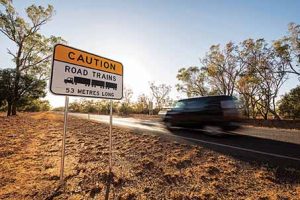 At the beginning of the 400-mile journey, both vehicles are set up as B-doubles. The ‘Proudly made in Australia’ truck will gradually shrink in length as its trailers are added to the white one. In Australia, the word B-doubles refers to a formation that consists of a prime-mover with a pair of semi-trailers – ‘B’ signifying a fifth wheel and ‘double’ because there are two of them. It is 25 m long and is running at 60-tonnes. Although B-doubles have to operate on approved routes, they are widespread. Out on the road, it is evident at once how well the trailer tracks – which just as well as Australian B-double drivers have a huge amount of pride in their driving standards, and scuffed rear tyres are to be avoided at all costs. Navigating through the suburbs on the way to the main freight route west, impressive is how little the trailers cut in.
At the beginning of the 400-mile journey, both vehicles are set up as B-doubles. The ‘Proudly made in Australia’ truck will gradually shrink in length as its trailers are added to the white one. In Australia, the word B-doubles refers to a formation that consists of a prime-mover with a pair of semi-trailers – ‘B’ signifying a fifth wheel and ‘double’ because there are two of them. It is 25 m long and is running at 60-tonnes. Although B-doubles have to operate on approved routes, they are widespread. Out on the road, it is evident at once how well the trailer tracks – which just as well as Australian B-double drivers have a huge amount of pride in their driving standards, and scuffed rear tyres are to be avoided at all costs. Navigating through the suburbs on the way to the main freight route west, impressive is how little the trailers cut in.
Out on the open road, the configuration feels incredibly stable. Reckons Manton that the B-double is better planted than a regular tractor unit and semi-trailer as the two trailers hold each other down. He says statistically it’s safer too, seeing as its heavier and therefore slower than a regular artic.
While cornering, it does not take long to observe that the mirrors on this truck are different than those of the European spec truck. Instead of being convex, the glass is completely flat. Apparently, this makes it easier to judge distances, which is especially important when reversing a B-double. “We prefer flat mirrors as main mirrors, but our smaller spotter mirrors are convex,” explains Manton. “We use those for seeing where trailers are on bends, and for checking on vehicles overtaking us.”
Although initially daunting, the truck turns out to be far more manoeuvrable around town than expected. In fact, once comfortable with the dimensions, it’s no challenge at all.
Harder to get used to is the stone guard. It is distracting. About 85 miles outside Brisbane is Toowoomba, Australia’s second-largest in-land city. It’s 700 m above sea level and calls for a 4 km climb with a 10 per cent gradient. The advice is to select a manual override on the I-Shift transmission at 60-tonnes. Crawling up at 30 kph in sixth gear, the rev-counter sitting at 1,200rpm, the B-doubles come down the hill. They are likely to be in the same gear as us, slowly but surely descending, engine brakes on full. Manton tells us that the police regularly follow trucks down the steep gradient, issuing fines if brake lights illuminate. The city is a transport hub, and the sheer variety of trucks on the road is amazing. Australia is one of the few markets where European, North American and Japanese trucks compete with each other. In total, there are almost 20 marques to choose from, including three from the Volvo Group – Volvo, Mack and UD; four from Daimler – Mercedes-Benz, Freightliner, Western Star and FUSO; Paccar’s DAF and Kenworth brands; TRATON’s Scania and MAN; market-leader Isuzu; Iveco, and Dennis Eagle. The Chinese have had a few attempts at breaking into the market, but have so far failed.
At Toowoomba is Simon National Carriers. A Volvo customer, it has had a good relationship with the manufacturer. It has been testing prototype Volvos since the 1980s, and currently has a Euro-6D truck on its fleet. Volvo carries out a lot of hot-weather testing in Australia, which it can do in parallel with winter testing back in northern Sweden. The reason for the visit to use its yard is to attach the third trailer, taken from a green and yellow truck. For the next 200 miles it will follow with a single semi-trailer and a dolly – both of which will later be added to our combination. Before the third trailer is added, there arises a need to reverse the B-double. It proves to be surprisingly easy after some coaching from Manton. It’s simply a case of right hand down if you want the trailer to go to the right, and vice versa.
B-triple
There are now three trailers and three-fifth wheels. The B-triple name comes from that. Combinations such as these can legally operate at a maximum of 83-tonnes and 36.5 m. This truck is now slightly under 82-tonnes and measures 32 m in length. Like the B-double, it has a maximum permitted speed of 100 kph. At under 82-tonnes, the statistics read that the truck is now 22-tonnes heavier. The increase in weight is barely felt from the driver’s seat. Although acceleration is slightly more lethargic, once cruising it doesn’t feel any different to that of the B-double. The truck combination does not handle any different. Explains Manton that it is far more stable than conventional three-trailer road trains, which use two dollies, giving them additional pivot points. Even on rough roads, the B-triple follows perfectly. It is surprising to see so little lateral movement in the mirrors.
Entering an agricultural area, it is easy to spot some elderly vehicles parked in the farmyards. The average age of a truck in Australia is 14 years. Typically, a prime-mover will cover 250,000 km per year and will spend its first few years hauling combinations over vast distances. During its second life, it is likely to move between major cities on the east coast, returning to base every night. At 1.2 million km it may have an engine rebuild, and then shunt trailers locally. When it reaches two-million km it will probably be sold to a farmer. Roads in Australia are in a poor state of repair. Trucks suffer as a result. Tyre wear is accelerated, and suspension components take a lot of punishment. To reduce the impact of the bumps, truck drivers tend to straddle the central white line on quiet roads. Riding on the crest of the road is considerably smoother, and is kinder on the truck, driver and the freight. In rural Queensland, the roads are narrow. There’s barely enough room for two vehicles to pass, which makes meeting other B-triples something of a challenge.
On narrow roads, the recognised technique is to ease off the accelerator, manually change down a gear, drop your nearside wheels onto the dirt, and accelerate steadily. If the approaching truck does the same, you should pass each other with little drama. Re-joining the road sometimes causes the trailers to dance somewhat. Applying the trailer brake (or stretch brake as it’s known in Europe) soon sorts that out. At this point, with the passing truck disappearing into the distance, you get on the CB radio and exchange pleasantries for a few minutes. CBs are vital, and get plenty of use. In addition to warning other truck drivers about potential hazards – like approaching wide loads, floods, bush fires or escaped livestock – striking up a conversation is a great way of fighting fatigue.
Some 250 miles into the journey, the fields of cereal crops have been replaced by cows searching for food in the dry scrub. A whole herd is occasionally passed by. These amount to a movement by cattle drovers. Although it is necessary to erect temporary fencing to prevent the cows from wandering onto the road, there is little evidence of it being the case. It’s surprising that they should take this risk. If a driver hits a cow on the road, a farmer or drover could be sued for any damage to the vehicle. The next stop is a road-train coupling site on the outskirts of Roma.
BAAB quad
The sun is setting, and the need to expedite the journey to Roma is necessary since there is no lighting here. Hooking up the fourth and final trailer is quite a time-consuming process. It is far more complicated than simply attaching it to the end of the current combination. It calls for uncoupling the three existing trailers and coupling the new trailer and dolly to the prime mover. An attempt to back it onto the three existing trailers proves rather harder than we expected, the dolly apparently having a mind of its own. ‘I think they must pay British drivers by the hour,’ quips Manton during our fifteenth shunt! Although it would have been easier to have attached the fourth trailer at the back of the existing outfit, Manton explains that this would have been dangerous. He tells us that the closer the dolly is to the prime-mover, the more stable the road-train is. The addition of the fourth and final trailer means that the road-train is now 52 m long and weighs 120 tonnes, the maximum plated weight.
One could legally drive 4,000km to Perth on the east coast with this combination. This drive is planned to be about 100 miles down to Morven. The Roma road-train coupling site is a hive of activity. A driver of a BAAB quad has driven here from Darwin, and can’t get any closer to Brisbane in this configuration. He drops his trailers and waits for a pair of B-double ‘dog-runners’ to turn up. Between them, they’ll take his four trailers east, while he’ll take their four west. It’s certainly a logistical challenge. There’s also a pair of B-double livestock trucks (aka stock crates) that take turns at backing onto an empty livestock road-train. Between the three drivers they transfer 250 cows into the road-train, which leaves in the direction of Darwin. Before leaving, the road-train display sign is put on the front and rear of the truck. From now on the maximum speed would be 90 kph. All that’s left to do is to perform a walk-round check. It takes four times longer than usual. After making sure to press the minus button on the I-Shift control as the gear is engaged to let the gearbox learn about the load, the forward journey begins.
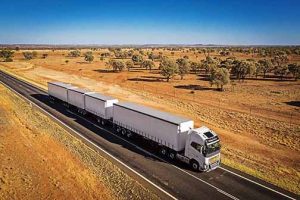 An interesting part of the minus button is that the button has to be pressed every time a new trailer is added or removed. Doing so also ensures that the truck sets off in first gear. The dolly, with its two pivot points, has made the truck slightly less stable. Small movements in the steering wheel are now amplified along the length of the truck. Manton explains that road train drivers must never hold the steering wheel too close to their bodies, and should instead push it towards the instrument cluster. This lets them hold it at arm’s length, and steer with their shoulders, instead of their arms. It has the effect of keeping movements to a minimum. It can be seen in the mirrors that the trailers wobble a bit on rough patches of road. An occasional use of the trailer brake is needed to keep them in check. Manton mentions that if it gets really bad, and starts to shake uncontrollably, the best thing to do is accelerate hard while engaging the trailer brake. Applying the footbrake, which might be a natural instinct, could result in a jackknife. Despite its incredible length, the truck feels only slightly less manoeuvrable than the B-triple. The dolly acts like the drive wheels of a prime mover, so from back there it has the same swept path and turning dimensions as a B-double.
An interesting part of the minus button is that the button has to be pressed every time a new trailer is added or removed. Doing so also ensures that the truck sets off in first gear. The dolly, with its two pivot points, has made the truck slightly less stable. Small movements in the steering wheel are now amplified along the length of the truck. Manton explains that road train drivers must never hold the steering wheel too close to their bodies, and should instead push it towards the instrument cluster. This lets them hold it at arm’s length, and steer with their shoulders, instead of their arms. It has the effect of keeping movements to a minimum. It can be seen in the mirrors that the trailers wobble a bit on rough patches of road. An occasional use of the trailer brake is needed to keep them in check. Manton mentions that if it gets really bad, and starts to shake uncontrollably, the best thing to do is accelerate hard while engaging the trailer brake. Applying the footbrake, which might be a natural instinct, could result in a jackknife. Despite its incredible length, the truck feels only slightly less manoeuvrable than the B-triple. The dolly acts like the drive wheels of a prime mover, so from back there it has the same swept path and turning dimensions as a B-double.
Feeling very heavy, which is quite obvious going up and downhill, the road-train doesn’t feel 120-tonnes heavy. It is a testament to the torquey characteristics of the 16-litre engine. When Australia gets the EuroVI version, with its twin turbos, it will be better again. The I-Shift continually switches between 11th and 12th on undulating hills. It makes better sense to engage manual and select 11th. This helps to maintain a quicker average speed. While old-school road train drivers are able to sense blow-outs on rear trailer tyres from the way the truck behaves, less experienced drivers stand little chance of noticing them. This is of course even more of an issue when driving at night, when it isn’t possible to spot the rubber disintegrating in the mirrors. A far more worrying aspect of night time driving in the Outback is hitting animals. Throughout the day, countless kangaroos were seen sitting lazily in the shade under trees. With the sun setting, they seemed to come to life. The headlights started picking up hundreds of them at the side of the road. Every so often one wanders out into the middle of the road on our approach an they’re quite big, said Manton. There is the temptation to brake, or attempt to swerve around them, but either evasive action would have disastrous consequences, he mentioned.
The only thing a road-train driver can do upon spotting a Kangaroo wander in the path is to wash a bit of the speed off. Sound the electronic horn (not the air horn as this startles them) and turn the main beam off. Cutting the main beam is crucial, as bright lights tend to freeze them to the spot. Worse still they cause a shadow of the kangaroo on the road behind it, which the animal believes to be another animal about to attack it, forcing it to run into the truck’s path. We have a number of narrow escapes, fortunately. Other drivers have been less lucky as kangaroo carcasses litter the road. The carnage is incredible, considering how few vehicles are actually using the road tonight. Picking the way through the remains, being careful not to flatten any dead ones, as the last thing one would want is a rib cage puncturing a tyre, it is evident that the dingos and wild cats are already starting their evening meals. They are seen dragging dead kangaroos off the road to feast on. “Bullbars are part of the circle of life,” says Manton. “We kill the roos, which feed the coyotes, birds, dingos and wild cats,” he explains.
In his 30 years of driving road trains, Manton has had most animals bounce off his bull-bar. He has even had close encounters with wild camels.
The worst thing I have probably hit is a swarm of bees, Manton says. “They hit the windscreen, and it was like a shotgun going off. I put the wipers on but that just made matters worse, as they were all carrying honey. I couldn’t see a thing.” Pulling up at a cafe in Morven, which has a truck park the size of a small country, it is time to cool off. A BAAB quad could not have worked in the UK. A B-double could since they are manoeuvrable, safe, productive and have the ability to slash the UK’s carbon footprint. Even Manton mentions it. “This is exactly the kind of innovation your country needs to be looking at,” he states. He has visited the UK, and knows. “If you want, you can change your combinations around, and have shorter trailers. If your first trailer is shorter and your second trailer is longer, this will give you a better-swept path. All your RDCs are close to your motorways, and your motorway system is better than ours,” he adds. If the UK were to go down this route, then obviously it would require some serious investment in infrastructure and training. The £8.2 million earmarked for platooning should be thrown into the fund.
Volvo in Australia
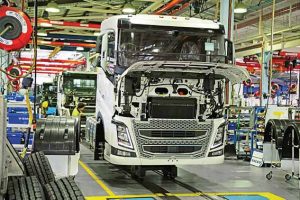
Volvo has had a presence in Australia since 1966, and has been assembling trucks in Brisbane since 1972. It’s fiercely proud of its manufacturing facility, and assembles FM, FH and FH16, using 30 per cent local content. Sourcing local suppliers has been challenging in recent times because Australia’s car industry has been decimated. Over the last few years Toyota, Holden and Ford have all ceased building cars, resulting in the closure of some component suppliers. The factory employs 560 people and 50 R&D engineers. Last year, Volvo produced 2,100 trucks in Australia, giving it a healthy share of the 14,344-strong market at 16-tonnes and above.
How to reverse
It’s easy to tie oneself in knots when reversing a road-train because of the multiple articulation points. The golden rule to follow is, every time a point of articulation is added, the way to turn the steering wheel changes. In the case of B-double (two points of articulation), it is right hand down for the trailer to go to the right, and vice versa. In the case of B-triple (three points of articulation), it is left hand down for the trailer to go to the right, and vice versa. In case of a BAAB quad (five points of articulation), the addition of a dolly introduces two new points of articulation. So, like with the B-triple, for the trailer to go to the right, it’s left hand down and vice versa. An attempt to reverse the 52 m road train confirmed that the system works – for a few metres! Anything further than that and it all starts to go wrong. “Not many road train drivers can reverse them,” says Manton. “The problem is the dolly, which kicks out, and is difficult to control. My best advice is not to get into a situation where you need to reverse it in the first place,” he said.
Stopping distances
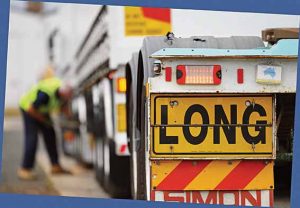 In days of old, road-trains had similar stopping distances to their rail travelling namesakes. But things have improved considerably in recent years. According to Manton, a typical one-trailer 43-tonne artic with a Volvo prime-mover will stop in 170 m when travelling at 90 kph, or in 195 m at 100 kph. In comparison, a 120-tonne road-train will take between 250 m and 300 m.
In days of old, road-trains had similar stopping distances to their rail travelling namesakes. But things have improved considerably in recent years. According to Manton, a typical one-trailer 43-tonne artic with a Volvo prime-mover will stop in 170 m when travelling at 90 kph, or in 195 m at 100 kph. In comparison, a 120-tonne road-train will take between 250 m and 300 m.
———————————————————–
CV is an associate member of the International Truck of the Year (IToY). As part of this association, the magazine provides exclusive articles, written especially by IToY jury members.




